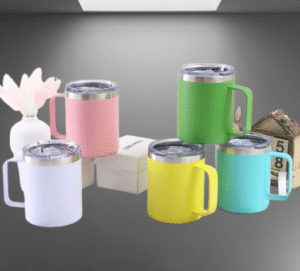You have a perfect idea for a new stainless steel bottle. But finding a reliable factory feels overwhelming, and you're worried about making a costly mistake with the wrong partner.
To find the right manufacturer, you must first create a detailed product specification sheet. Then, research suppliers, ask targeted questions about their quality control and certifications, and always order physical samples before committing to a bulk order.
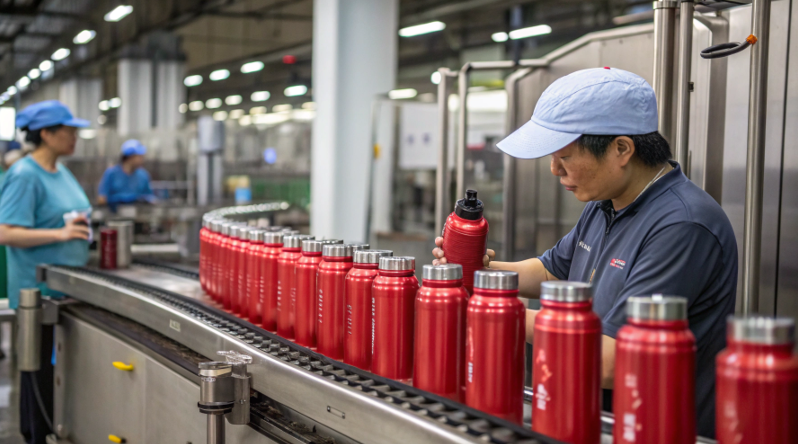
I remember working on a project where the client was tempted by an incredibly low price from a new factory. It seemed too good to be true. I insisted we follow our standard vetting process, especially requesting detailed reports on their steel sourcing. It turned out they were using a lower grade of stainless steel, which could have been a disaster for my client's brand. This experience taught me that a good partnership is built on transparency and proven quality, not just a low price tag. Your manufacturer is your most important business partner.
How is a stainless steel bottle actually manufactured?
You know what a great bottle looks like. But you're unsure about the complex manufacturing process, making it hard to discuss technical details intelligently with potential suppliers.
A bottle is made from a steel tube that is cut, shaped with water pressure (hydroforming), and welded. For insulated versions, two bottles are nested, and the air between them is vacuum-sealed before the final polishing and coating.
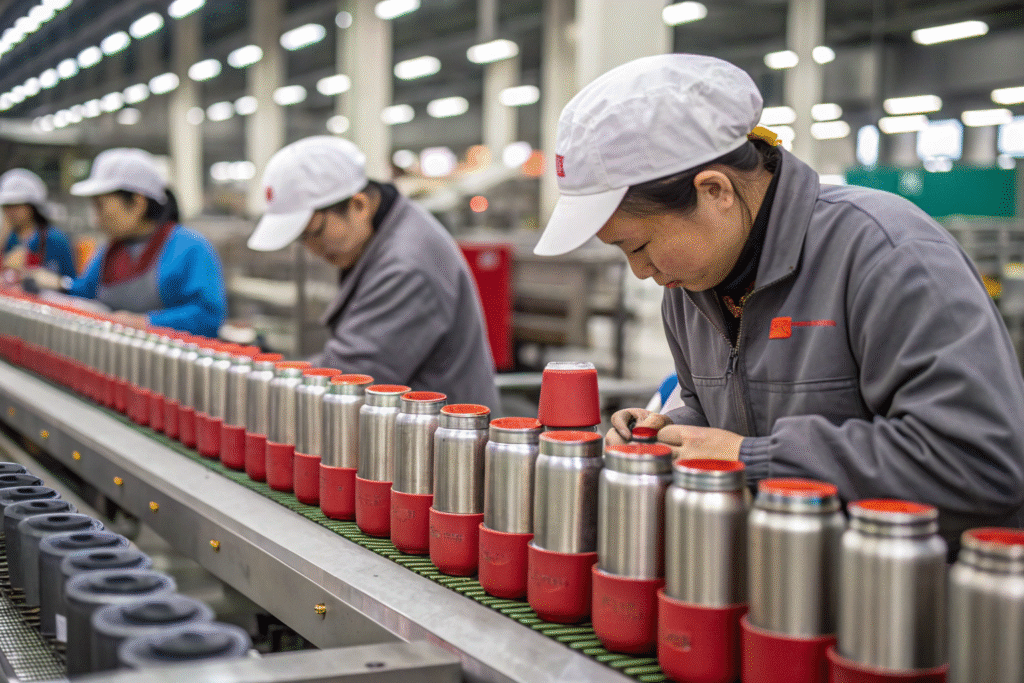
Walking through a bottle factory is like watching a symphony of machinery. Each step is critical. I've learned that if you can talk to a factory manager about the specifics of their hydroforming pressure or their vacuum chamber process, you earn a different level of respect. It shows you're a serious partner who understands quality. For a product developer like Emily, knowing these steps is not just technical knowledge; it's a tool for better negotiation and quality assurance. It helps you pinpoint exactly where things can go wrong and what to check for in your samples.
From Steel Tube to Finished Product
Understanding the manufacturing journey is key to controlling quality. Here are the main stages:
- Stage 1: Pipe Cutting & Shaping
A long tube of food-grade stainless steel (usually 304, or 18/8) is cut to size. Then, through a process called hydroforming, water is blasted into the tube at extreme pressure, forcing it to expand and take the shape of the outer mold. This is how complex bottle shapes are created. - Stage 2: Welding
The top "mouth" of the bottle is precisely cut and welded together. For an insulated bottle, an inner bottle is created using the same process. The two are then nested, and the bottom bases are laser-welded shut. The quality of this weld is critical for durability. - Stage 3: Vacuum Insulation
This is the most important step for performance. The assembled bottle is placed in a vacuum oven. The air between the inner and outer walls is pumped out, creating a vacuum that prevents heat transfer. A "getter," a small chemical pellet, is activated to absorb any remaining gas molecules. - Stage 4: Finishing
The bottle is mechanically and electrolytically polished to create a smooth, clean surface. Finally, it's sent for exterior finishing, most commonly a durable powder coating or spray paint.
How do you start a successful reusable bottle business?
You dream of launching your own successful water bottle brand. But the path from a great idea to a profitable business seems overwhelming and full of potential pitfalls.
A successful bottle business starts with a clear customer niche and brand story. Then, you must focus on thoughtful design, finding a reliable manufacturer, building a marketing plan, and managing your logistics and customer service effectively.
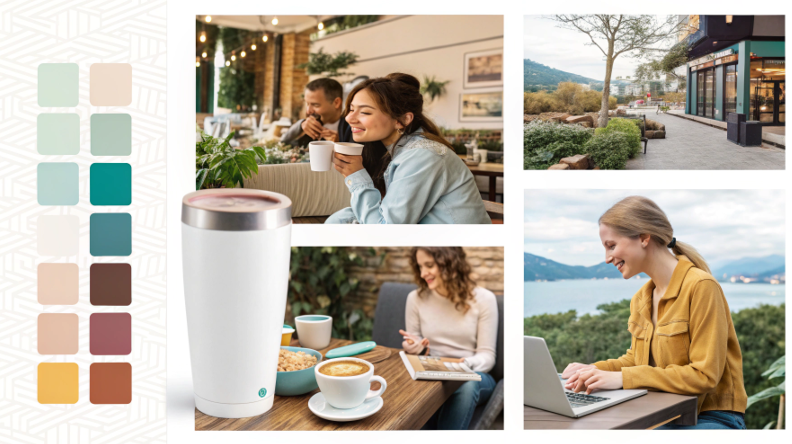
I've seen many amazing bottle designs fail because they didn't have a story or a clear customer. I once helped a client who had a beautiful bottle but no idea who to sell it to. We went back to the drawing board and redefined their target customer as "urban commuters who value compact, leak-proof design." This simple shift changed everything. We adjusted the marketing, the packaging, and even the color palette. The business took off because they were no longer selling a bottle; they were selling a solution to a specific person's problem.
The Blueprint for Your Brand
Launching a business is more than just creating a product. It's about building a brand.
| Step | Key Actions | Why It's Important |
|---|---|---|
| 1. Find Your Niche | Identify your ideal customer. Is it a hiker, a student, a yoga enthusiast, a parent? What are their specific needs? | You can't appeal to everyone. A specific audience is easier to target and market to. |
| 2. Build Your Brand | Develop your brand name, logo, color palette, and voice. What does your brand stand for? Sustainability? Performance? Style? | Your brand is your promise to the customer. It creates an emotional connection beyond price. |
| 3. Design & Manufacture | Create a unique design. Find a reliable manufacturing partner by vetting them thoroughly, as discussed in this article. | The quality of your product and your supplier will determine your brand's reputation. |
| 4. Pre-Launch Marketing | Build an email list and social media following before your product arrives. Create excitement and anticipation. | A successful launch requires having an audience ready to buy on day one. |
| 5. Plan Logistics | Decide how you will store, pack, and ship your products. Set up your customer service system. | Poor fulfillment or customer service can quickly ruin a great product and brand. |
Where are most stainless steel water bottles made?
You need to source your bottles and want to know where the expertise lies. You hear "Made in China" but worry about what that means for quality and communication challenges.
The overwhelming majority of stainless steel insulated water bottles are made in China. The city of Yongkang, in Zhejiang province, is the undisputed global hub for this industry, home to thousands of factories and a complete supply chain.

My first visit to Yongkang was eye-opening. You can't drive for more than a few minutes without seeing a business related to drinkware—steel suppliers, mold makers, lid specialists, powder coating shops, packaging printers. It's an entire ecosystem built around one product. This concentration is the reason why the world's biggest brands produce here. While navigating the culture and language can be a challenge, the level of expertise and manufacturing capability is simply unmatched anywhere else in the world. For a developer, this is where innovation happens.
Sourcing from the Industry Hub
Working with manufacturers in Yongkang offers incredible advantages, but it's important to be aware of the realities.
- The Power of the Cluster: Yongkang is known as the "Cup Capital of China." This industrial cluster means everything you need is in one place. If your factory needs a special kind of lid or a new coating technique, there's a specialist supplier right down the road. This speeds up development and innovation immensely.
- Unmatched Expertise: These factories have been making bottles for decades. They have the skilled labor and advanced machinery to produce high-quality, complex designs at a massive scale. Their engineers have likely solved any problem you can think of.
Here's a simple breakdown for a developer like Emily.
| Pros of Sourcing in Yongkang | Cons of Sourcing in Yongkang |
|---|---|
| Highly competitive pricing | Time zone & language barriers |
| Deep manufacturing expertise | Cultural differences in business |
| Huge capacity for scale | Potential for quality fade if unmanaged |
| Massive customization options | Requires rigorous, independent QA |
Why is Gen Z so obsessed with their water bottles?
You see trendy water bottles all over social media. You're trying to figure out if it's just a fleeting trend or if there's a deeper consumer psychology you can tap into for your brand.
For Gen Z, a water bottle is a personal accessory and a status symbol. It represents their values—sustainability and wellness—while also serving as a canvas for self-expression through colors, stickers, and brand choices.
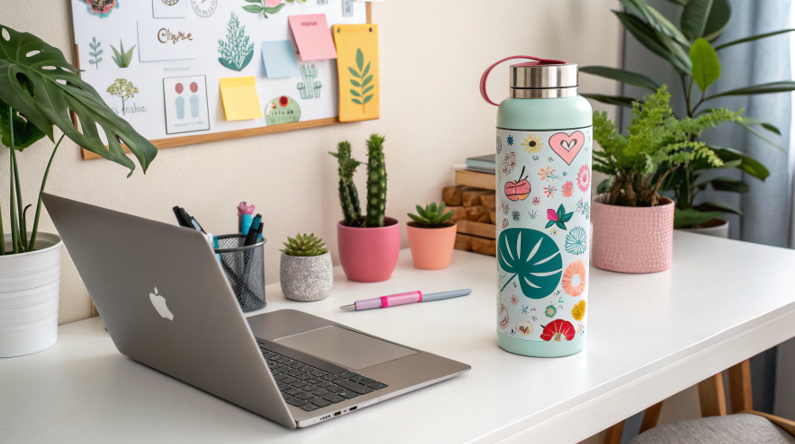
The Stanley cup phenomenon isn't really about the cup. I've analyzed this with my team, and we realized it's a masterclass in modern marketing to Gen Z. It's about scarcity (limited color drops), community (collectors sharing their finds), and identity (customizing the cup with accessories). This generation doesn't just buy a product; they join a culture. For a product developer, this means you need to think beyond the physical object. How can your bottle become a status symbol? How can it help a young person express who they are?
Decoding the Water Bottle Obsession
To design a product for Gen Z, you must understand the key drivers behind this trend.
- 1. An Badge of Sustainability: Gen Z has grown up with a strong awareness of environmental issues. Carrying a reusable water bottle is an easy, visible way for them to practice their values and reject single-use plastic. It's a small act of personal activism that they can perform every day.
- 2. A Health and Wellness Symbol: The "that girl" aesthetic on TikTok and Instagram promotes a lifestyle of wellness, productivity, and health. A large, ever-present water bottle is a key prop in this narrative. It signals a commitment to hydration and self-care.
- 3. A Canvas for Self-Expression: The water bottle has become part of the outfit. Limited-edition color drops make them collectible, like sneakers. The ability to cover them in stickers or add custom accessories like charms and silicone boots allows for deep personalization. It's a way to signal your identity and what you care about.
Conclusion
Finding the right stainless steel bottle manufacturer is the foundation of your brand. By understanding the manufacturing process, the market, and the customer's psychology, you can build a successful and lasting business.

